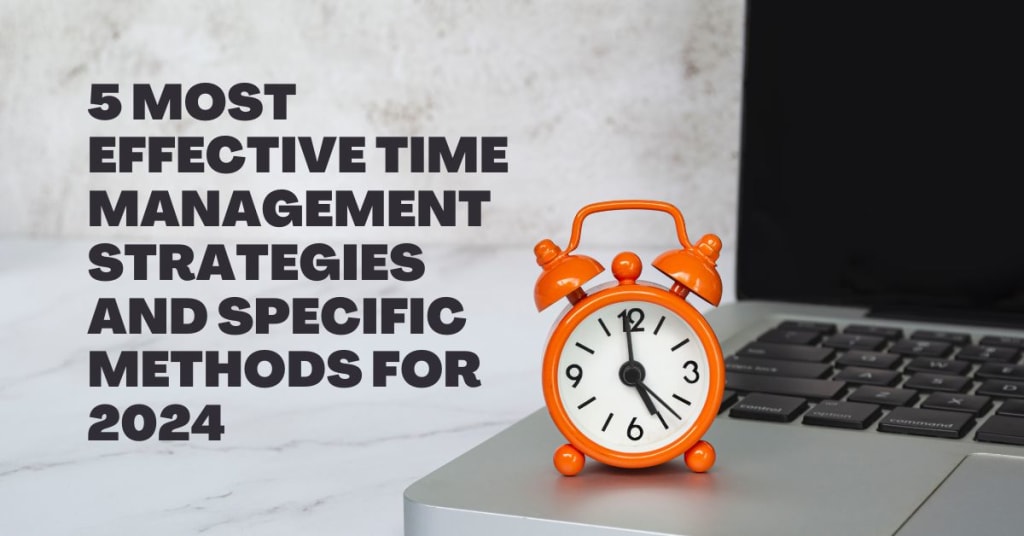Content warning
This story may contain sensitive material or discuss topics that some readers may find distressing. Reader discretion is advised. The views and opinions expressed in this story are those of the author and do not necessarily reflect the official policy or position of Vocal.
5 Most Effective Time Management Strategies and Specific Methods for 2024
In our fast-paced lives, one of the most indispensable aspects is efficiency in getting things done. This efficiency isn't just about speed; it's about being both fast and accurate. To achieve this level, we must master one crucial skill: time management. In my previous article, "Have You Implemented Time Management in 2024?", I discussed what time management is, the factors that affect it, and more. If you haven't read it yet, I recommend checking it out first to better understand what time management is and how to do it correctly. Back to today's topic, achieving high efficiency requires excellent time management methods to achieve exponential results; otherwise, it will fail. Here are the five most effective time management strategies and specific methods for 2024.

I. Goal Setting and Prioritization
1. Goal Setting
Set specific, measurable, achievable, relevant, and time-bound goals (the SMART principle). Clear goals provide direction and motivation, giving people a defined path in their time management efforts. Here is a simple example of using the SMART method to pass the TOEFL exam:
Specific:
Goals should be clear and precise, not vague. For example, "improve English proficiency" is not specific enough; it can be revised to "pass the TOEFL exam within six months." Then, outline the necessary plan to pass the exam within six months, such as watching videos by native English speakers every day and learning at least five new words each week. The more specific and clear the plan, the better. People are more motivated when the steps are clear and achievable rather than feeling aimless like a headless chicken.
Measurable:
Goals should have clear criteria for measurement. For example, set a specific score target to measure your TOEFL exam performance. You can also conduct a mock test each month to gauge your progress and gain a sense of accomplishment. This way, you can create your unique method to assess your skills and enjoy a personal sense of achievement.
Achievable:
Goals should be realistic and achievable, neither too easy nor too difficult. For example, set a reasonable score target based on your current English level. Instead of aiming for a perfect score of 100, you might set a goal of 70 or 60. The specific score is not the main point; the key is to set a goal that surpasses your previous performance but is still within your reach. The reason is simple: if you choose something beyond your capability and fail to achieve it, you might feel disappointed and ultimately decide to give up.
Relevant:
Goals should be closely related to personal or professional development. For example, improving English proficiency can be beneficial for future career advancement. While English is important, what’s more crucial is striving for your future. Effective time management is about accomplishing what you want to do. Therefore, choosing goals that can help in your career development becomes even more important.
Time-bound:
Goals should have a clear deadline. For example, "pass the TOEFL exam within six months." Goals with deadlines are more effective than those without. Think about it: if a task requires an indefinite amount of time, you might feel reluctant to choose it. This highlights the importance of having a time limit.
2. Prioritization
Use the Eisenhower Matrix:
Categorize tasks based on their importance and urgency into four categories: important and urgent, important but not urgent, urgent but not important, and not important and not urgent. Prioritize tasks that are important and urgent first, followed by those that are important but not urgent.
- Important and Urgent:
Handle immediately. For example, important projects with looming deadlines.
- Important but Not Urgent:
Schedule time to address. For example, long-term career development planning.
- Urgent but Not Important:
Delegate or streamline. For example, unimportant urgent meetings.
- Not Important and Not Urgent:
Avoid if possible. For example, trivial social media browsing.
II. Time Blocking
1. What is Time Blocking
In simple terms, time blocking involves dividing the 24 hours of a day into several segments and assigning each segment to a specific task. By organizing tasks in this manner, you can ensure that your mind remains clear and focused despite having numerous tasks, thereby increasing efficiency and improving time management without wasting time.
2. How to Implement Time Blocking
Create a Daily Plan
You can take 30 minutes before bed to create a schedule for the next day. During this planning time, allocate specific tasks to each time segment and write them down in detail.
08:00 - 09:00: Exercise
09:00 - 10:00: Handle emails and communication
10:00 - 12:00: Project work
12:00 - 13:00: Lunch break
13:00 - 15:00: Meetings
15:00 - 17:00: Project work
17:00 - 18:00: Review and plan for the next day
18:00 - 19:00: Dinner
19:00 - 21:00: Personal development
21:00 - 22:00: Relaxation
The above is an example. You can use this as a foundation and make adjustments to suit your own needs.
Set Clear Time Segments
The length of each time block should be determined based on the complexity and importance of the tasks, typically ranging from 30 minutes to 2 hours. Ensure each time block has a clear start and end time. Of course, everyone’s habits and capabilities are different, so adjust according to your own abilities; you don't have to strictly follow the 30-minute to 2-hour guideline.
You can start by observing how long it takes you to complete each task for a week. However, during this week, you must stay extremely focused and avoid distractions like checking your phone. This will ensure the times you observe are accurate. Inaccurate durations will significantly affect the precision of your schedule.
Focus on One Task
Within each time block, focus on a single task and avoid multitasking. Turn off email notifications, social media, and other distractions to ensure concentration.
Rest and Adjust
Schedule short breaks between time blocks, such as 5-10 minutes. This helps maintain energy and focus. At the end of each day, review your time block plan and make adjustments based on actual performance and insights.
It's important to note that the 5-10 minute breaks are meant to give you a brief rest, and this time should be included in your task duration. For example, if a task requires one hour to complete and you need two breaks of 10 minutes each, then the total time to complete the task would be 1 hour and 20 minutes.
In your schedule, there's another type of break for leisure activities. This leisure time should be separate from your short work breaks. Mixing them can make it difficult to get back to the task at hand.
A helpful tip is to avoid thinking about your next task during your leisure time. If you spend your leisure time thinking about tasks, you won't feel truly rested or relaxed. Consequently, you'll lack the energy and focus needed for the next task.
In summary, work during work time and relax during leisure time. Learn to unwind; if you can't relax, your efficiency in completing tasks will significantly decrease.
III. Pomodoro Technique
1. What is the Pomodoro Technique
The Pomodoro Technique is a simple yet effective time management method that involves breaking work time into 25-minute intervals (called "pomodoros") with short breaks in between. This approach helps to enhance focus and productivity.
2. How to Implement the Pomodoro Technique
Choose a Task
First, select a task that needs to be completed and break it down into smaller tasks that can be finished within 25 minutes each.
Set a Timer
Set a timer for 25 minutes and start working. During these 25 minutes, focus entirely on the selected task and avoid any distractions.
Take a Short Break
When the 25-minute work period ends, take a 5-minute break. During this time, you can stand up, move around, drink water, or do other relaxing activities.
Repeat the Cycle
After completing four "pomodoros," take a longer break, typically 15-30 minutes. Repeat the process until the task is completed.
Differences Between the Pomodoro Technique and Time Blocking
To be honest, these two methods seem quite similar at first glance, but there are some key differences.
1. Length of Time Segments:
- Pomodoro Technique: The time segments are shorter, typically 25 minutes.
- Time Blocking: The time segments are longer, usually 1-2 hours.
2. Frequency of Breaks:
- Pomodoro Technique: After every 25 minutes of work, there is a 5-minute break, with a longer break after completing four "pomodoros."
- Time Blocking: Each time block is followed by a short break, but the frequency and length of breaks are not fixed.
3. Task Focus:
- Pomodoro Technique: Focuses on a single task, suitable for short-term high-intensity work.
- Time Blocking: Allows for handling different tasks in different time blocks, suitable for multitasking and long-term work.
4. Flexibility:
- Pomodoro Technique: Has a more fixed structure, suitable for tasks that require strict time control.
- Time Blocking: More flexible, suitable for work that requires adjustments based on task importance and urgency.
The Pomodoro Technique and Time Blocking each have their advantages and disadvantages, catering to different time management needs. The Pomodoro Technique enhances focus and productivity through short bursts of high-intensity work, making it suitable for tasks requiring high concentration. On the other hand, Time Blocking ensures that each task has enough time to be completed through comprehensive planning and time allocation, making it suitable for multitasking and long-duration work. Depending on individual and work-specific circumstances, one can choose the appropriate method or combine both to achieve optimal time management results.
IV. Daily Review and Weekly Planning
1. Daily Review
Record Daily Task Completion
At the end of each day, spend 5-10 minutes reviewing the completion of the day's tasks. Note which tasks were completed, which were not, and any difficulties or challenges encountered.
Analyze Time Usage
Analyze how your time was spent throughout the day. Identify any time-wasting activities or areas of inefficiency. For example, consider whether too much time was spent on unimportant tasks or if you were frequently interrupted.
Summarize Lessons Learned
Summarize the day's lessons learned and think about how to improve your time management strategies. Record successful experiences and effective methods so that you can continue to apply them in the future.
2. Weekly Planning
Set Weekly Goals
At the beginning of each week, spend 15-30 minutes setting your goals and task list for the week. Based on your long-term goals, set specific weekly goals and break them down into daily tasks.
Create a Schedule
Based on your weekly goals and daily tasks, create a detailed schedule. Allocate time blocks and tasks for each day to ensure that every task has enough time to be completed.
Regularly Adjust Plans
At the end of the week, conduct a comprehensive review and summary. Adjust the plans and goals for the following week based on actual progress and circumstances, ensuring continuous improvement of your time management strategies.
V. Utilizing Modern Technology and Automation Tools
1. Digital Calendars and Task Management Apps
Google Calendar:
Google Calendar is a widely-used online calendar application that supports cross-device synchronization. Users can set event reminders, create recurring events, and share calendars with others. By using Google Calendar, you can better manage your schedule and tasks, avoiding the risk of forgetting important events.
Todoist:
Todoist is a popular task management app that supports project management, task assignment, priority setting, and progress tracking. Users can create task lists, set due dates and reminders, and collaborate with team members.
2. Time Tracking Tools
Toggl:
Toggl is a time tracking tool suitable for freelancers and teams. Users can log the time spent on each task, generate reports, and analyze their time usage. By using Toggl, you can gain a better understanding of your time allocation, identify time-wasting activities, and improve work efficiency.
Rescue Time:
Rescue Time automatically tracks your activities on your computer and phone, providing detailed time usage reports to help you identify time wasters. By using Rescue Time, you can better manage and control your online activities, avoiding time wasted on social media and other distractions.
3. Pomodoro Technique Apps
Pomodone:
Pomodone combines the Pomodoro Technique with task management, allowing users to work in focused 25-minute intervals followed by 5-minute breaks. By using Pomodone, you can effectively implement the Pomodoro Technique, enhancing focus and productivity.
Focus Booster:
Focus Booster is a simple Pomodoro Technique app that provides work and break timers, as well as time usage reports. By using Focus Booster, you can easily track and manage your work time, maintaining a high-efficiency work state.
Final Thoughts
In an era where time is our most precious resource, mastering time management is essential for both personal and professional success. The strategies discussed—such as prioritization with the Eisenhower Matrix, time blocking, the Pomodoro Technique, task batching, and leveraging technology—offer practical solutions to the challenges of modern life. By implementing these methods, you can enhance productivity, reduce stress, and create a more balanced and fulfilling lifestyle. Remember, effective time management is not just about working harder, but about working smarter and making the most of every moment.
GET MORE ARTICLES? IT’S HERE >C.CALVIN’S LIFE BLOG
About the Creator
lifeisconfusing_butstillalive
I'll be sharing my life experiences, personal profile, solutions to problems and highlights of books I've already read.






Comments
There are no comments for this story
Be the first to respond and start the conversation.